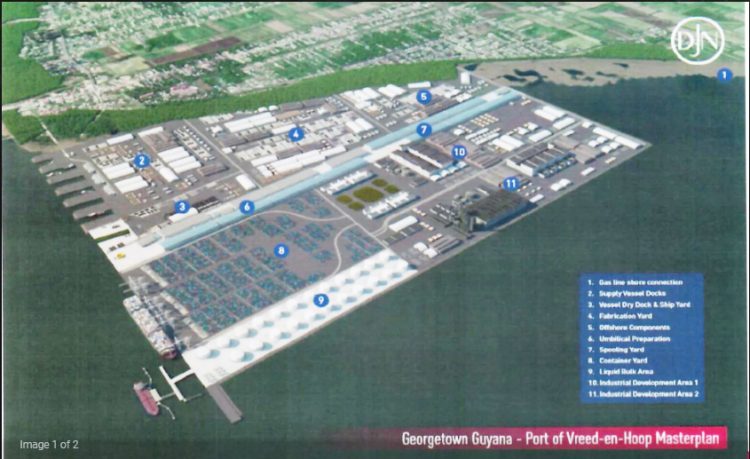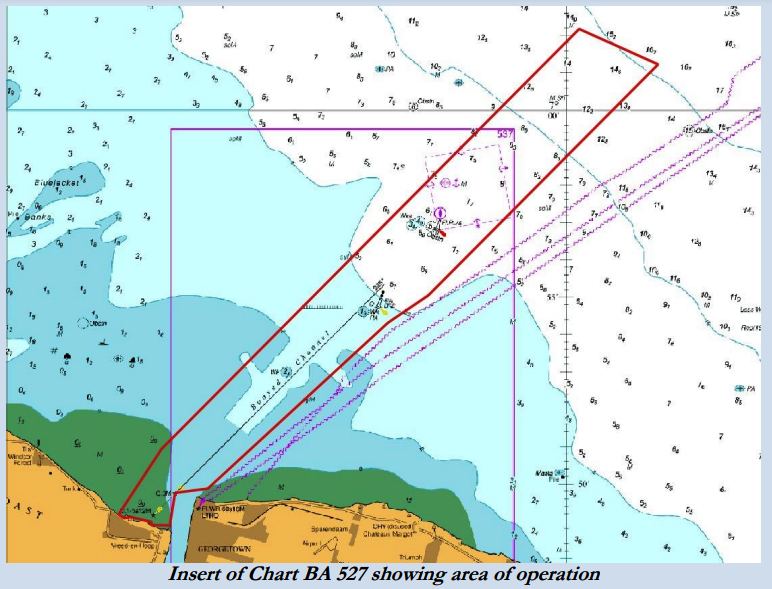In the absence of an Environment Impact Assessment (EIA) for the Vreed-en-Hoop shore base project, questions are now being raised about possible impacts of the ongoing dredging activities on fish stocks and nurseries in the area.
On September 06, 2021, the Environmental Protection Agency (EPA) granted an environmental permit to NRG Holdings Incorporated, clearing the way for the start of its projected US$600 million Vreed-en-Hoop oil and gas shore base development. The EPA had said that the Best Village, West Coast Demerara (WCD) shore base would not require an EIA, noting that the project was screened and categorised as having no significant impacts.

Last month, NRG Holdings turned the sod to officially commence construction of the US$300 million shore base. In April, VEHSI and ExxonMobil Guyana signed the agreement for shore base services to be provided at the Port of Vreed-en-Hoop Facility. This is the first shore base to begin construction in the region.
In June, NRG Holdings announced that the ‘Zheng He’ had arrived in Guyana for the commencement of phase one of the project which would see the deepening, widening and dredging of the access channel as well as land reclamation.
On June 28, the Maritime Administration Department (MARAD) announced that “dredging activities would be conducted in the vicinity of the Demerara Main Ship Channel and off the West Coast of Demerara in the vicinity of Plantation Best.”
In a notice to mariners, MARAD said that the exercise is scheduled to conclude on December 31, 2022, and will see the utilization of TSHD Galileo Galilei and TSHD De Bougain-ville. It added that the vessels would display the international signal for vessels engaged in such activities. MARAD added that the dredging area covers an area of 34.74 square nautical miles (119.2 square kilometres).
It advised mariners to stay clear of the vessels and navigate with extreme caution when in the vicinity.
In another notice, MARAD informed that the dredging activities commenced on July 1.

In a letter to the editor, published in today’s Stabroek News, environmentalist Janette Bulkan questioned the effects of the dredging operations.
“The area defined for dredging crosses traditional fishing grounds of the artisanal fishermen. Few fishermen read the newspapers and I am not aware of any other attempt to inform them of the disruption to their business,” she said.
The ‘two trailing suction hopper dredges’ (TSHD) are owned by Dutch company Jan De Nul – a partner in the Vreed en Hoop Shore Base Incorporated (VEHSI). The vessels can dredge to a depth of 30 metres.
Bulkan reminded that the present entry channel is much shorter, narrower and can be dredged 5-6 metres.
Triple the depth
“The two dredgers have capacities of 18,000 m3 and 4,000 m3. It seems from the MARAD notice number 113 that ExxonMobil’s intention is to triple the depth of the channel to 15 metres.
“By its nature, dredging disturbs the natural environment and, here, affects the livelihoods of fishermen. Fishers have both legal and customary rights to their traditional fishing grounds. I cannot find any call by the Environmental Protection Agency to demand an Environ-mental Impact Assessment. Where is the dredged mud to be discharged, between now and the end of 2022? The EIAs for the first four fields (Liza-1, Liza-2, Payara and Yellowtail) all disclaim attention to dredging. This is stated to be associated with and the responsibility of the shore-base owners/operators, and is expressly excluded from the EIAs. The EPA’s covering statement for the Liza-2 EIA mentions ‘pipe yards and bonds’ onshore but not any dredging,” the letter states.
Bulkan also called on the EPA for an explanation of why there is no EIA for the dredging.
“I also call for protection of the legal and customary rights of fishers to their traditional fishing grounds,” she added.
Stabroek News reached out to the Executive Director of the EPA Kemraj Parsram for additional information on the activities and its impact on the environment but was unsuccessful.
Additionally, this newspaper also reached out to the Director of NRG Holdings, Nicholas Deygoo-Boyer who directed all questions to their Public Relations Consultant Christopher Chapwanya. An email containing questions was sent to Chapwanya and a response was promised later today.
According to the project summary, the coastal and near-shore ecosystem is home to many of Guyana’s commercial “fish” species including the bangamary (Macrodon ancyclodon), the Guyana seatrout (Cynoscion virecens), prawns (Penaeus spp.), seabob (Xiphopenaeus kroyeri), the white belly shrimp (Nematopalaemon schmitti) and crabs e.g., blueback (Callinectes bocourti), the bunderi (Cardiosoma guanhami) and the red sheriga (Portunus rufiremus).
It added that important commercial species of the marine ecosystem include the gill backer (Sciades spp.), red snapper (Lutjanus purpureus). The document further reported that fish species recorded from fish studies by EEPGL in 2017 and 2018 found 6 species of fish with Sciaenidae (drums and croakers), Ariidae (sea catfishes), and Engraulidae (anchovies) being dominant and diverse. The most common species observed at the nearshore were white spring cariss, highwaterman catfish, parassi mullet, and pemecou sea catfish, and crabs.
It also stated that the design and components of the proposed project are not expected to significantly impact flora and fauna in the area.
The shore base, which is being undertaken by VEHSI, is a component of the Port of Vreed-en-Hoop project. VEHSI is a joint venture between NRG Holdings Incorporated—a Guyanese-owned consortium comprising Hadi’s World Incorporated, National Hardware Limited and ZRN Investments Incorporated—and Jan De Nul, a Luxembourg-based engineering and construction firm that specialises in marine services, offshore services, civil engineering, environmental management activities and project development.
VEHSI serves as a Special Purpose Vehicle (SPV) for the 20-acre shore base. NRG Holdings Inc.—the developer of the Port of Vreed-en-Hoop project— holds an 85 per cent stake in the joint venture.
The facility is expected to generate at least 300 jobs during the construction phase while the jobs generated during the operation phase will depend solely on the needs of Exxon. In April, Boyer had said that the construction methodology is heavy equipment-based, so there will be a demand for operators and equipment movers. He said that VEHSI is a sub-project of the Port of Vreed-en-Hoop masterplan and 85% of the shares are owned by Guyanese. The other 15% is held by the contractor Jan De Nul Group. The facility will occupy some 400 hectares of coastland.
The shore base development will include facilities such as general/heavy loading berths, storage/laydown yards, construction offices, mess hall, parking, and backup generators.
In April, President of ExxonMobil Guyana, Alistair Routledge had told reporters that VEHSI is an important project because it would enable investors in the oil and gas sector to do more. He said that VEHSI’s role will be different from that of Guyana Shore Base Incorporated (GYSBI) at Houston. GYSBI is Guyana’s first shore base facility and has enabled Exxon to move almost all of its supply chain for drilling and production operations from Trinidad to Guyana.
“What VEHSI allows us to do is to bring more of the construction activities, the preparation for installation of subsea equipment. Everybody tends to focus on the vessel that’s on the surface – the FPSO, but we put just as much investment on the seabed and into wells,” he had said.
He added that some of the fabrication of jumpers and steel plates to go on the seabed to connect the wells are being done in Guyana at a smaller facility – at SAIPEM – but with VEHSI coming on board that would increase capacity significantly.



